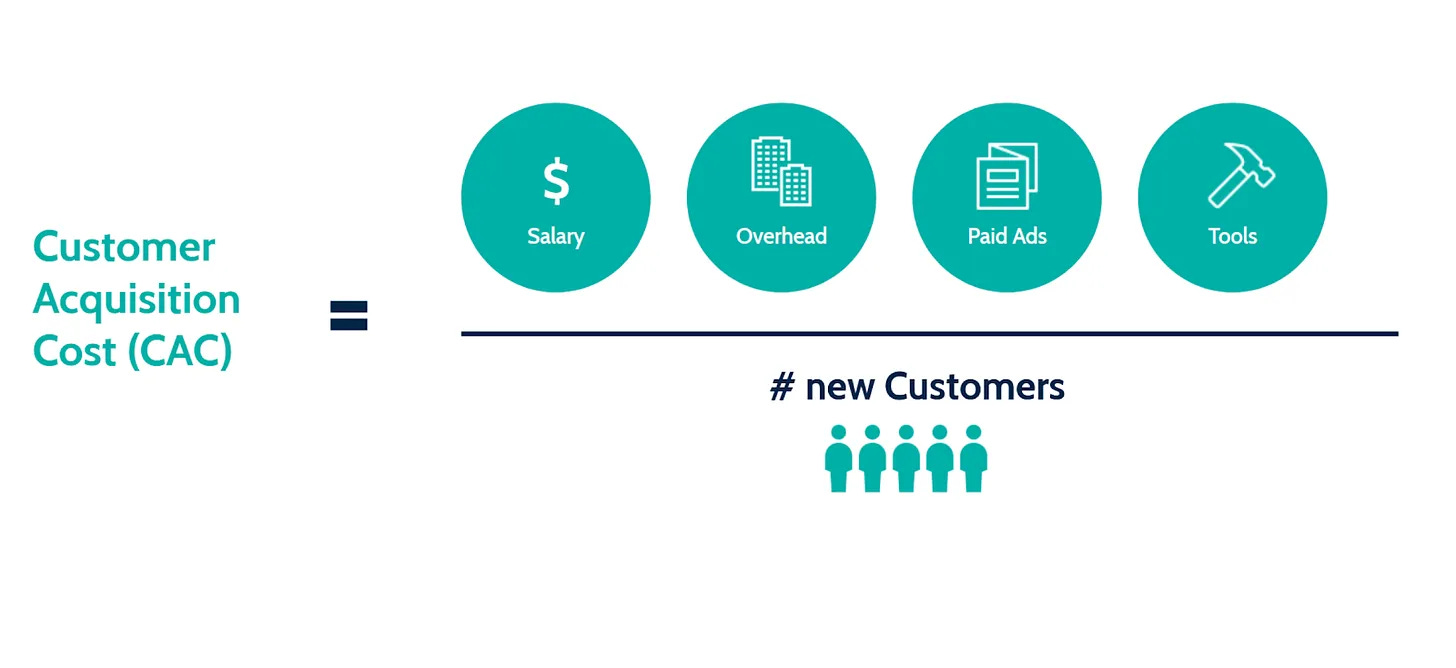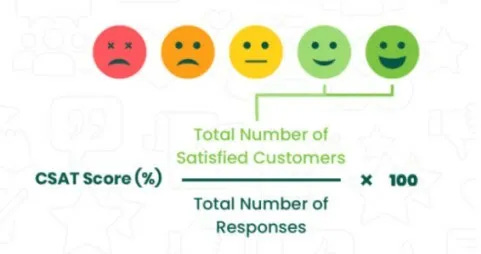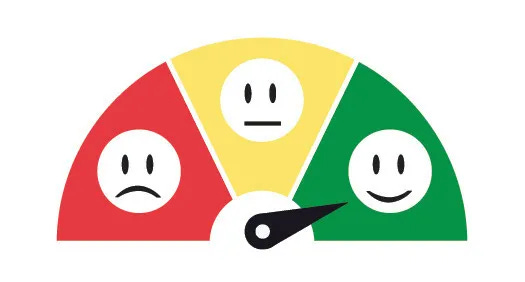5 Essential Customer Success Metrics to Boost Your Business Growth
[Last Updated: Aug 17, 2024]
In Customer Success, building strong partnerships with customers is the key to delivering exceptional business outcomes.
To measure the impact of your CS strategies and track progress, you need to focus on critical performance indicators.
While metrics like NRR, MRR, CLV, CES, and NPS are key, five additional metrics can take your Customer Success game to the next level.
Here are the powerful metrics that will revolutionize your day-to-day customer interactions.
1. CAC: Customer Acquisition Cost
Customer Acquisition Cost (CAC) is a vital metric that reveals the amount of money your company spends to acquire a new customer.
Tracking CAC will help you identify the most cost-effective strategies for customer acquisition.
The formula for CAC is straightforward:
CAC = (Total Sales and Marketing Expenses) / (Number of New Customers Acquired)
Example:
Social media campaign cost: $5,000
New customers acquired: 5
CAC for social media channel: $1,000
A lower CAC indicates a better return on investment for your company.
According to a recent study by Profitwell, the average CAC for SaaS companies has increased by 55% over the last five years. (Source: touchpoint)
This underscores the importance of monitoring and optimizing this metric.
"Understanding your CAC is key for sustainable growth. It's not just about acquiring customers, but doing so efficiently." - David Skok, Venture Capitalist and founder of ForEntrepreneurs
Kirsten DiChiappari, VP of Customer Success at vCom Solutions, emphasizes the importance of balancing acquisition costs with customer experience:
"If you lead with a great product, packaged in an exceptional customer experience, retention, renewals, and expansion should be strong enough to achieve operational goals. If you skimp on the product or experience, you will never achieve true sustainable success."
Read my full interview with Kirsten DiChiappari for more insights.
💡For more insights on optimizing your CAC, check out my Customer Acquisition Cost Calculator for SaaS.
2. MAU: Monthly Active Users
Monthly Active Users (MAU) measures the number of unique users engaging with your platform within a 30-day period.
This metric is key for assessing performance, growth, and usage levels across different customer segments.
To track MAU:
Use unique identifiers like user ID, username, or email
Define "active" based on specific actions (e.g., creating 5 marketing campaigns per month)
A higher MAU indicates stronger user engagement and platform adoption.
According to Mixpanel's 2023 Product Benchmarks Report, top-performing apps see an average of 32% of their MAU engaging with the product daily. (Source: SupportYourApp)
Kevin Herrholtz, VP of Customer Success at AddShoppers, shares his approach to tracking user engagement:
"All of our clients have success plans where we target their specific business outcomes and set benchmark KPIs that are time-based to ensure we consistently track them."
Read my full interview with Kevin Herrholtz for more insights.
💡Learn more about leveraging MAU in my guide on Digital Customer Success Trends.
3. CSAT: Customer Satisfaction Score
The Customer Satisfaction Score (CSAT) is a popular metric that quantifies customer satisfaction with your products or services.
It's calculated as a percentage:
Aim for a CSAT score of 70-80%, which is the average across most industries.
Higher scores indicate greater customer satisfaction and loyalty.
"CSAT is a direct reflection of how well you're meeting customer expectations. It's a powerful tool for identifying areas of improvement and celebrating successes." - Shep Hyken, Customer Service and Experience Expert
Krystel Leal, Head of Customer Success at OneText, emphasizes the importance of personalized feedback collection:
"For feedback at many of the SaaS companies I have led, we use NPS and frequent surveys based on milestones and support. All feedback is gathered by category, i.e. product or issue, and reviewed each month in-depth to write up trends."
Read my full interview with Krystel Leal for more insights.
💡For more strategies on boosting customer satisfaction, read my article on Customer Success Communication Skills.
4. CHS: Customer Health Score
The Customer Health Score (CHS) is a key metric for monitoring customer relationships.
Typically tracked using a color-coded system (Green/Yellow/Red), CHS focuses on two key areas:
Activity
Product usage
Use CHS to identify at-risk customers (Yellow/Red) and develop targeted recovery plans to bring them back to a healthy status (Green).
A 2023 report by Gainsight found that companies using a well-defined CHS system saw a 12% increase in customer retention rates compared to those without such a system. (Source: Velaris)
Gillian Core, Former SVP of Customer Success at Placer AI, shares her approach to CHS:
"We also adjusted our customer health score to be calculated only based on a customer's consumption of our products and services. You can have a highly profitable customer who gives you a 10 on an NPS but still has a very low health score because they only use one thing you offer."
Read my full interview with Gillian Core for more insights.
💡Learn how to build an effective CHS in my guide on How to Build Customer Health Score in HubSpot.
5. TTV: Time to Value
Time to Value (TTV) measures how long it takes for customers to realize the benefits of your solutions.
This metric is key for evaluating the ROI of time and money invested in your product or service.
While defining "benefit" and "value" can be challenging, striving for a shorter TTV ensures customers maximize their return on investment quickly.
A study by Forrester Research found that companies with a strong focus on reducing TTV saw a 20% increase in customer lifetime value. (Source: customerly)
Melissa Garcia, Director of Renewal Operations at Chief, emphasizes the importance of understanding customer goals:
"Customers are primarily interested in their own KPIs, not ours. Understanding this starts with attentive listening, asking pertinent questions, and then articulating how our offering aligns with their goals. It's about demonstrating tangible proof of value over and over."
Read my full interview with Melissa Garcia for more insights.
💡For more insights on optimizing TTV, check out my Customer Onboarding Checklist Guide.
Implementing and Tracking These Metrics
To effectively leverage these metrics, consider the following best practices:
Establish baselines: Determine your current performance for each metric to set realistic improvement goals.
Set SMART goals: Create Specific, Measurable, Achievable, Relevant, and Time-bound objectives for each metric.
Implement tracking tools: Use customer success platforms or analytics tools to automate data collection and reporting.
Regular review and analysis: Schedule periodic reviews to assess progress and identify areas for improvement.
Cross-functional collaboration: Share insights with sales, marketing, and product teams to drive company-wide improvements.
"The key to success is not just tracking these metrics but using the insights gained to continuously refine and improve your Customer Success strategies." - Nick Mehta, CEO of Gainsight
Lara Barnes, former SVP of Customer Success at Sitecore, emphasizes the importance of collaboration:
"I am very commercial in my mindset and work collaboratively with sales, after all, why are we all there—it's to grow the business. Everyone should be a salesperson."
Read my full interview with Lara Barnes for more insights.
💡For more on implementing effective CS strategies, read my Ultimate Guide: Customer Success Managers.
The Impact on Customer Success Strategies
Mastering these five Customer Success metrics - CAC, MAU, CSAT, CHS, and TTV - will help you get invaluable insights into your customers' journey and be better equipped to drive business growth.
These metrics will help you:
Optimize acquisition strategies and reduce costs
Increase user engagement and product adoption
Improve overall customer satisfaction and loyalty
Identify and mitigate churn risks proactively
Accelerate time-to-value for new customers
A recent study by Harvard Business Review found that companies that effectively use customer success metrics see a 2.5x higher revenue growth rate compared to their peers.
As Kirsten DiChiappari notes:
"Balance has to be real - not BS. If you lead with a great product, packaged in an exceptional customer experience, retention, renewals, and expansion should be strong enough to achieve operational goals."
And That’s It
A strategic approach to Customer Success is key.
Focusing on these five critical metrics alongside traditional KPIs will help you deliver exceptional customer experiences, drive growth, and achieve long-term success.
The key to success is not just tracking these metrics but using the insights gained to refine and improve your Customer Success strategies continuously.
Stay agile, keep learning, and always put your customers at the center of your efforts.
As Kevin Herrholtz advises:
"Leadership is an action, with the title being awarded post-action. Roll up your sleeves and contribute anywhere you positively can in your organization, and eventually will be recognized."
I hope that helps,
Hakan.
💡For more insights on building a successful Customer Success career, check out my Customer Success Career Guide.
Sources:
Profitwell, "The State of SaaS Spend 2023"
Mixpanel, "2023 Product Benchmarks Report"
American Customer Satisfaction Index, "ACSI National Economic Indicator 2023"
Gainsight, "Customer Success Industry Report 2023"
Forrester Research, "The ROI of Customer Experience, 2023"
Harvard Business Review, "The Value of Customer Success Metrics, 2023"








